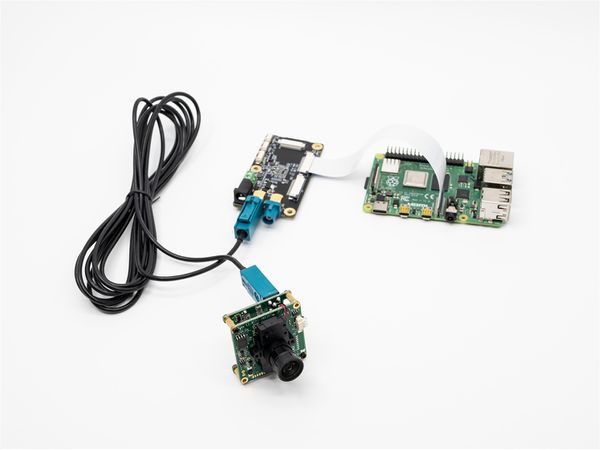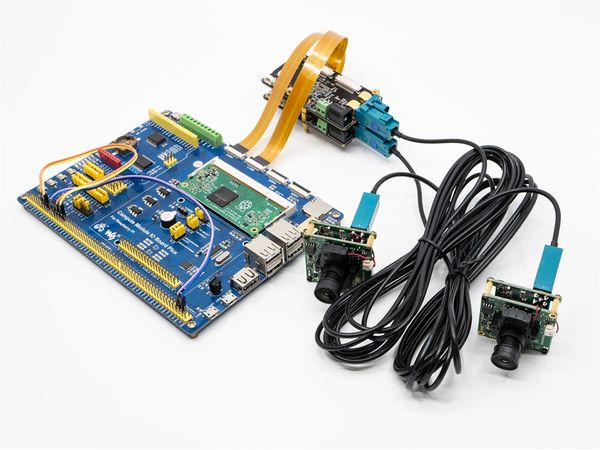Difference between revisions of "CS-FPD-CAM for Raspberry Pi"
| Line 23: | Line 23: | ||
== RaspberryPi System Setup and Configuration == | == RaspberryPi System Setup and Configuration == | ||
| − | + | Completely consistent with : [[CS-MIPI-X for Raspberry Pi#RaspberryPi System Setup and Configuration|RaspberryPi System Setup and Configuration]]. | |
== Sofware Toolkits Install == | == Sofware Toolkits Install == | ||
| − | + | Completely consistent with : [[CS-MIPI-X for Raspberry Pi#Sofware Toolkits Install|Sofware Toolkits Install]]. | |
| + | |||
| + | In addition, we provide a FPD-Link III script for configuring the FPD-Link board. | ||
== FPD-Link III shell script manual == | == FPD-Link III shell script manual == | ||
| − | < | + | On Raspberry PI, you need to configure I2C pins, please refer to: [[CS-MIPI-X i2c#RaspberryPi Only.2C Set IO config|raspberry pie pin configuration]] part2, and then do the following. |
| + | ===fpdlink3_i2c.sh Usage=== | ||
| + | $ ./fpdlink3_i2c.sh | ||
| + | |||
| + | Usage: ./fpdlink3_i2c.sh [-f] function name -b bus -p port -p1 param1 -p2 param2 -p3 param3 | ||
| + | |||
| + | options: | ||
| + | |||
| + | -f [function name] function name | ||
| + | |||
| + | -b [i2c bus num] i2c bus number | ||
| + | |||
| + | -p [fpdlink port] fpd link port number [0,1] | ||
| + | |||
| + | -p1 [param1] param1 of each function | ||
| + | |||
| + | -p2 [param1] param2 of each function | ||
| + | |||
| + | -p3 [param1] param3 of each function | ||
| + | |||
| + | support functions: rpi_init,sync_init,trigger_init | ||
| + | |||
| + | '''fpdlink port:[[FPD-LINK3-2RX Data Sheet index|FPD-LINK3-2RX]] board,J3 is fpllink port 0, J4 is fpdlink port 1.''' | ||
| + | ===fpdlink3_i2c.sh usage details=== | ||
| + | =====rpi_init===== | ||
| + | <code>./fpdlink3_i2c.sh -f rpi_init -p 0/1</code> | ||
| + | |||
| + | init the FPD-Link channel of port0/1,'''must run this command before you can connect video and i2C.''' | ||
| + | =====sync_init===== | ||
| + | <code>./fpdlink3_i2c.sh -f sync_init -p 0 -p1 0</code> | ||
| + | |||
| + | Configure port 0 as the master of sync mode. | ||
| + | |||
| + | Connect J1 signal of [[FPD-LINK3-TX Data Sheet index|FPD-LINK3-TX]] on port 0 to J6 of [[FPD-LINK3-2RX Data Sheet index|FPD-LINK3-2RX]],direction is TX-->RX. | ||
| + | |||
| + | <code>./fpdlink3_i2c.sh -f sync_init -p 1 -p1 1</code> | ||
| + | |||
| + | Configure port 1 as the slave of sync mode. | ||
| + | |||
| + | Connect J8 signal of [[FPD-LINK3-2RX Data Sheet index|FPD-LINK3-2RX]] to J1 of [[FPD-LINK3-TX Data Sheet index|FPD-LINK3-TX]] on port 1 ,direction is RX-->TX. | ||
| + | =====trigger_init===== | ||
| + | <code>./fpdlink3_i2c.sh -f trigger_init -p 0</code> | ||
| + | |||
| + | Configure port 0 as the trigger mode. | ||
| + | |||
| + | Connect J6 signal of [[FPD-LINK3-2RX Data Sheet index|FPD-LINK3-2RX]] to J1 of [[FPD-LINK3-TX Data Sheet index|FPD-LINK3-TX]] on port 0 ,direction is RX-->TX. | ||
| + | |||
| + | <code>./fpdlink3_i2c.sh -f trigger_init -p 1</code> | ||
| + | |||
| + | Configure port 1 as the trigger mode. | ||
| + | Connect J8 signal of [[FPD-LINK3-2RX Data Sheet index|FPD-LINK3-2RX]] to J1 of [[FPD-LINK3-TX Data Sheet index|FPD-LINK3-TX]] on port 1 ,direction is RX-->TX. | ||
== Typical application == | == Typical application == | ||
| + | |||
| + | === CS-FPD-CAM-IMX327 Video usage === | ||
| + | [[File:RaspberryPi4 connect with CS-FPD-CAM.jpg|center|thumb|600x600px|RaspberryPi4 connect with CS-FPD-CAM|link=http://wiki.veye.cc/index.php/File:RaspberryPi4_connect_with_CS-FPD-CAM.jpg]] | ||
| + | =====Step 1:===== | ||
| + | On Raspberry PI: | ||
| + | |||
| + | <code>./fpdlink3_i2c.sh -f rpi_init -p 0</code> | ||
| + | |||
| + | Init the FPD-Link channel of port0. | ||
| + | =====Step 2:===== | ||
| + | After Step 1, the stream acquisition and I2C instruction control of the camera are exactly the same as those of the camera with the MIPI interface. | ||
| + | |||
| + | *[[VEYE-MIPI-290/327 for Raspberry Pi|How to use VEYE-MIPI-X camera module on Raspberry Pi]] | ||
| + | *[[CS-MIPI-X for Raspberry Pi|How to use CS-MIPI-X camera module on Raspberry Pi]] | ||
| + | |||
| + | *[[CS-MIPI-X i2c|CS-MIPI-CAM I2C.sh Usage]] | ||
| + | |||
| + | *[[VEYE-MIPI-290/327 i2c/zh|VEYE-MIPI-290/327 I2C.sh Usage]] | ||
| + | |||
<br /> | <br /> | ||
Revision as of 10:08, 4 November 2020
1 Introduction
FPD-Link SerDes III is a coaxial remote transmission scheme of video stream provided by TI. We have designed FPD-LINK3-TX and FPD-LINK3-2RX boards, which can realize coaxial transmission of 1 or 2 channels of MIPI CSI-2 images, and the transmission distance can be up to 10 meters.
On the Raspberry PI platform, a set of FPD-LINK3-TX and FPD-LINK3-2RX boards are used to realize the remote transmission of 1-channel video. The I2C address of the camera after initialization configuration is the same as that of the original camera.
For application layer, a completely transparent FPD-Link channel is implemented, including image, i2C communication, synchronous IO and trigger IO.
Therefore, when using CS-FPD-CAM, you must refer to the following articles:
- How to use VEYE-MIPI-X camera module on Raspberry Pi
- How to use CS-MIPI-X camera module on Raspberry Pi
2 Hardware Setup
PS:FPD-LINK3-2RX need a 12V DC power.
3 RaspberryPi System Setup and Configuration
Completely consistent with : RaspberryPi System Setup and Configuration.
4 Sofware Toolkits Install
Completely consistent with : Sofware Toolkits Install.
In addition, we provide a FPD-Link III script for configuring the FPD-Link board.
5 FPD-Link III shell script manual
On Raspberry PI, you need to configure I2C pins, please refer to: raspberry pie pin configuration part2, and then do the following.
5.1 fpdlink3_i2c.sh Usage
$ ./fpdlink3_i2c.sh
Usage: ./fpdlink3_i2c.sh [-f] function name -b bus -p port -p1 param1 -p2 param2 -p3 param3
options:
-f [function name] function name
-b [i2c bus num] i2c bus number
-p [fpdlink port] fpd link port number [0,1]
-p1 [param1] param1 of each function
-p2 [param1] param2 of each function
-p3 [param1] param3 of each function
support functions: rpi_init,sync_init,trigger_init
fpdlink port:FPD-LINK3-2RX board,J3 is fpllink port 0, J4 is fpdlink port 1.
5.2 fpdlink3_i2c.sh usage details
5.2.1 rpi_init
./fpdlink3_i2c.sh -f rpi_init -p 0/1
init the FPD-Link channel of port0/1,must run this command before you can connect video and i2C.
5.2.2 sync_init
./fpdlink3_i2c.sh -f sync_init -p 0 -p1 0
Configure port 0 as the master of sync mode.
Connect J1 signal of FPD-LINK3-TX on port 0 to J6 of FPD-LINK3-2RX,direction is TX-->RX.
./fpdlink3_i2c.sh -f sync_init -p 1 -p1 1
Configure port 1 as the slave of sync mode.
Connect J8 signal of FPD-LINK3-2RX to J1 of FPD-LINK3-TX on port 1 ,direction is RX-->TX.
5.2.3 trigger_init
./fpdlink3_i2c.sh -f trigger_init -p 0
Configure port 0 as the trigger mode.
Connect J6 signal of FPD-LINK3-2RX to J1 of FPD-LINK3-TX on port 0 ,direction is RX-->TX.
./fpdlink3_i2c.sh -f trigger_init -p 1
Configure port 1 as the trigger mode.
Connect J8 signal of FPD-LINK3-2RX to J1 of FPD-LINK3-TX on port 1 ,direction is RX-->TX.
6 Typical application
6.1 CS-FPD-CAM-IMX327 Video usage
6.1.1 Step 1:
On Raspberry PI:
./fpdlink3_i2c.sh -f rpi_init -p 0
Init the FPD-Link channel of port0.
6.1.2 Step 2:
After Step 1, the stream acquisition and I2C instruction control of the camera are exactly the same as those of the camera with the MIPI interface.
- How to use VEYE-MIPI-X camera module on Raspberry Pi
- How to use CS-MIPI-X camera module on Raspberry Pi

